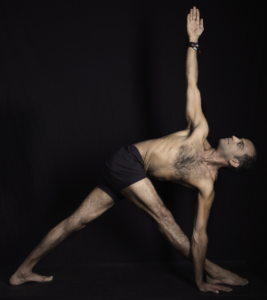 Last month, the Iyengar Yoga National Associate of the United States (IYNAUS) featured this conversation between two of Adeline Yoga’s very own: Renee Razzano and instructor Zain Syed. Enjoy!
Last month, the Iyengar Yoga National Associate of the United States (IYNAUS) featured this conversation between two of Adeline Yoga’s very own: Renee Razzano and instructor Zain Syed. Enjoy!
Renee Razzano: What inspired you to become a Certified Iyengar Yoga teacher?
Zain Syed: The principles of Iyengar Yoga teaching are so brilliant that I yearned to be certified to honor these principles and techniques. The more gratitude I received from students about my teaching the more I felt I had to be certified so as to give credit where credit is due, which is always B.K.S. Iyengar and the Iyengar family. Once I became certified I felt blessed to carry a ray of light from this family and brighten the world with the practice of yoga.
RR: How does your experience of being an immigrant relate to your practice of yoga? How about your experience of being a Pakistani American in particular?
ZS: To be honest, it has no effect. My identity as an immigrant is only effected when in relationship to others.
I’ve noticed a shift in people’s energy – with western white yogis, particularly – when they find out I’m not Indian – something they may sort of imagine an idealized yoga “teacher” to be – and then hearing I’m Pakistani there is a pause and surprise. It’s akin to the feeling when at the airport, going through TSA, you feel that suspicion of being profiled because of your Pakistani/Muslim background, which I find sort of comical. When I tell an Indian person, or another South Asian, that I’m a Pakistani American the usual response is “why, of course” as in, okay, we just had to figure out which side of the made up borders of our subcontinent we are from, and we move onto the next conversation of getting to know one another. I would love to see more Pakistanis, and South Asians in general, practicing in studios and at workshops.
RR: How did you get involved with the prison yoga project? How is the experience of teaching at San Quentin different from teaching elsewhere?
ZS: It feels like fate to me – I happened to be at a meditation center gathering when there was a request for a male person of color to teach in a prison. I connected with James Fox, the founder, and took over his class at San Quentin in 2012. Yoga in a prison is like no other class I’ve taught elsewhere. It’s my only class with all men and it is great to see them take interest in the subject.
Building trust with the guys is just as important as elsewhere. Language plays a key role. Actions like arms up or hands behind your back can have a different connotation at first. Or the words “past” or “life” or “time” can be heard differently than when we think of past life time. So the experience has taught me to teach people not poses. To meet them where they are and not get caught up in the technical aspects of practice.
Going to San Quentin every week is a reality check for me to be grateful for the privileged life I have, the family I have, the teachers I have, the friends I have. I always walk away with a tender heart and remind myself to not get worked up about petty problems.
RR: I’m aware you were personally impacted by the recent Ghostship warehouse fire in Oakland. Has your practice of yoga provided support as part of your grieving process, either solo or with other people?
ZS: My practice has served as a strong rock to keep me grounded as much as I can with my undulating emotions of deep sorrow and loss. For the first few weeks I was apprehensive to do back bends and yearned for long, deep forward folds. Teaching, to my surprise, was a sobering experience and cleared my head space. Holding a healing space for others, not to be caught in my own mind during even the most darkest of times, had a healing effect on myself. I see bodies differently and faces differently, eye contact and touch feels different, knowing how short and precious our time is while alive.
RR: You’ve got real talent and savvy with social media. What are your thoughts about the potential uses of social media for sharing yoga?
ZS: My use of video sharing online is inspired very much by B.K.S. Iyengar’s efforts to spread yoga across the world. He performed yoga as an artist and made the practice look fancy and fun. He attracted many audiences across the globe and gained their attention. So part of my mission on social media has become to make Iyengar Yoga look and feel cool because that is exactly what it is for me — anything but boring. My intention behind posting is nothing more than love for yoga. Following Mr. Iyengar’s artistry, I share my creativity with my body as a painter would with their canvas or a musician with their instrument. It is also a practice of Svadhyaya and Vairagya. To not be attached to the fruits of our labors, so in the case of social media, the number of likes, comments, or shares. I am grateful for support from the online community of yogis.
